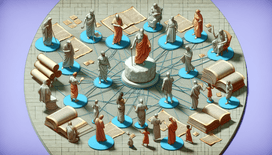Greetings, fellow explorers of the fantastical realms where history waltzes with technology! Strap in as we embark on a journey to ancient Egypt, where the sand dunes whisper secrets of builders past and petrified pharaohs who dreamed of heights that flirted with the heavens. But what’s this? Peeking through the shadows is a trickster of time, a hypothetical twist that inserts artificial intelligence into the construction of the Great Pyramid of Giza. Imagine the Pharaoh Khufu not only armed with an army of labourers but also an artificial brain capable of predictive analytics and data-driven decisions. Will it lead to the perfect pyramid or a sandstorm of existential questions? Let us don our histori-tech goggles and dive in!
The Pharaoh’s Point of View
Picture this: It’s 2580 BC and Pharaoh Khufu has just embarked on his ambitious project to create a monument as everlasting as the aspirations of his soul. However, our time-bending genie of a narrative has handed him an iPharaoh X packed with the wonders of AI.
Khufu, ever the innovator, asks his AI assistant, "Who am I?" not in search of philosophical musings but to ensure history remembers his name with eterne esteem. With a seamless interface more user-friendly than a sand moat, AI responds, "You are the sun of Ra, the architect of glory, the king with a blueprint of impeccable symmetry." Talk about getting a morale boost!
Architects and Algorithms
Enter Hemiunu, Khufu’s gifted vizier and chief architect. Known for his grand vision, Hemiunu now finds himself in the unprecedented company of an AI known as "GlyphBit," specifically programmed for architectural wizardry. With a flick of his reed stylus (stylus being so much classier than a mouse, after all), he communes with GlyphBit, asking, "How might we defy rocks and reach for the skies, oh digital oracle?"
The humble AI, with the capacity to process data at a speed that would make a camel’s gallop look like a leisurely stroll, replies, "The key lies in pyramidal precision. I propose a 51-degree incline, ensuring optimal stability and, dare I say, Instagrammable grandeur." With that, the blueprint begins to form, not chiselled in stone, but projected in pixel-perfect clarity.
A Labour Force with Laser Focus
Meanwhile, the workforce tasked with hauling tonnes of limestone and granite across the desert has undergone a digital transformation. Alas, the whip-cracking overseer is replaced by "CoachBot," an AI personal trainer and GPS-enabled taskmaster. These labourers, no longer just stony-faced and heavy-laden, now follow a path mapped by laser-precision AI algorithms.
“Steady, team,” chirps CoachBot with robotic encouragement, “next stop, 100 metres to your left. And remember, lift with your knees, not your backs, to avoid lower back pain and timesheet discrepancies!”
Morale soars along with stone blocks. Productivity is unparalleled, and the time to build the Great Pyramid shrinks quicker than a mirage evaporates at midday.
The Math and Mystique
A pivotal benefit of AI is its ability to calculate with mind-boggling accuracy. GlyphBit recalculates the mathematics behind the Golden Ratio, a construct revered almost as divine knowledge in ancient mathematics. The precision ensures each block locks into place with unrivalled accuracy, erasing the mysteries that scholars would puzzle over for millennia.
This reliance on cold, hard data leads to an existential conversation among scores of builders. "If everything can be predicted," muses one seasoned stone carrier, "does any mystery remain in this life, or beyond?" To which CoachBot quips, "The only mystery here, mate, is why there are no Wi-Fi hotspots in the afterlife."
Tourism-Touting Time Machine
The successful completion of the Great Pyramid marks not just a testament to architectural prowess but opens the sands of time to what many protégés might call ‘early tourism’. Armed with VR headsets, visiting dignitaries from lands afar experience the grandeur of the pyramid without ever leaving their palaces.
Khufu, beaming with pride, turns to Hemiunu, "Did we build a pyramid, or did we mould the sands of destiny?" To which Hemiunu, ever the pragmatic, replies, "Majesty, with curved lines and algorithms, we’ve done both. Let’s update your status to ‘World Wonder Builder’."
AI and the glory of Egypt, two colossal entities that, on this playful sojourn, crafted a legend. And if one were to ask whether humanity lost anything along the way...well, we gained a pyramid. Isn’t history just a hoot?







